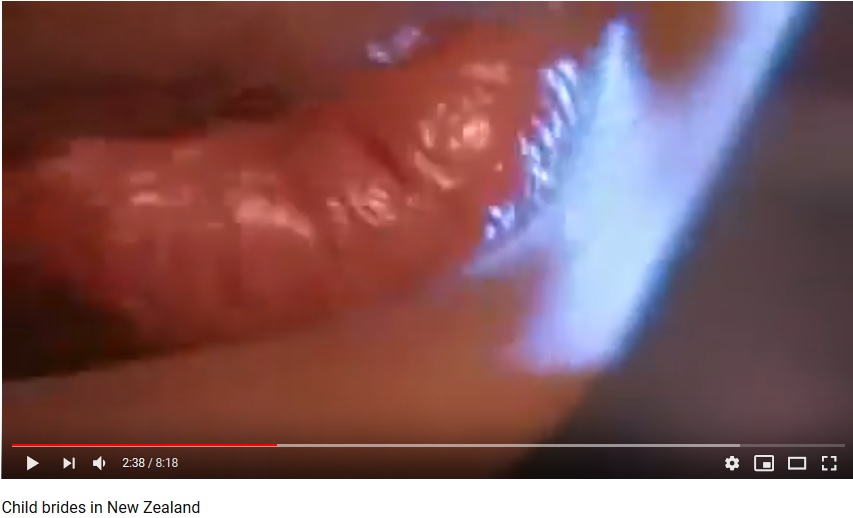See also: 14 & pregnant: Child brides & Sharia takes priority over NZ law.
See also: FIANZ protests to BSA of “unfair” portrayal of Islamic child marriage on NZ TV; it’s not their fault!


MPs have passed a bill to end female genital mutilation in New Zealand.New Zealand First spokeswoman for Human Rights Jenny Marcroft said in a statement last night, after the Crimes (Definition of Female Genital Mutilation) Amendment Bill passed all remaining stages, she wanted to protect girls and women from “abhorrent abuse”.“No matter how rare the practice of FGM (female genital mutilation) may be in our country it is our duty to protect women and girls from this emotional and physical abuse,” she said.
“This bill will close the loopholes and hopefully see an end to the importation of this barbaric practice.“Our Parliament’s united effort to end all types of FGM in New Zealand will be appreciated by the diaspora communities affected by it. We want to empower women from migrant communities.” The passing of the bill brings New Zealand in line with the World Health Organization classification of female genital mutilation.
“I am very proud to have been part of the very first cross-party multi-Member’s Bill. This is historically significant for us as parliamentarians and as women. What we have in common, might not be our minds or ideologies – but our bodies,” Ms Marcroft said. “The female body, which we are setting out to protect from powers who would seek to mutilate it in the name of religious tradition or culture.”
-TVNZ
Download the .pdf of the new Bill: Crimes Definition of Female Genital Mutilation Amendment Bill
Prevalence and Distribution
The World Health Organization (WHO) estimates that 200 million girls and women alive today have undergone female genital mutilation (FGM) in the countries where the practice is concentrated. An estimated 3 million girls are at risk of undergoing FGM mutilation every year and the majority of girls are cut before they turn 15 years old.Female genital mutilation has been documented in 30 countries, mainly in Africa, as well as in the Middle East and Asia. Some forms of FGM have also been reported in other countries, including among certain ethnic groups in South America. Growing migration and the refugee diaspora has also recently increased the number of girls and women living outside their country of origin who have undergone FGM or who may be at risk of being subjected to the practice in countries such as Europe, Australia, New Zealand and North America.
The type of FGM performed varies with ethnic group. Current WHO estimates indicate that around 90% of FGM cases include either Types I, II or IV and about 10% (over 8 million women) have Type III (infibulation). Infibulation, which is the most severe form of FGM with a higher rate of complications, is mostly practiced in the north-eastern region of Africa: Djibouti, Eritrea, Ethiopia, Somalia, and Sudan and is practised among as many as 90% of women from some of these countries.
Estimated prevalence of FGM in Africa
|
Countries |
Prevalence by Age (%) |
||
|
15-49 |
15-19 |
45-49 |
|
|
Benin |
7.3 |
2 |
12 |
|
Burkina Faso |
75.8 |
57.7 |
89.3 |
|
Cameroon |
1.4 |
0.4 |
2.4 |
|
Central African Rep. |
24.2 |
17.9 |
33.8 |
|
Chad |
44.2 |
41 |
47.6 |
|
Cote d’lvoire |
38.2 |
31.3 |
46.9 |
|
Dijbouti |
93.1 |
89.5 |
94.4 |
|
Egypt |
91.1 |
80.7 |
96 |
|
Eritrea |
88.7 |
78.3 |
95 |
|
Ethiopia |
74.3 |
62.1 |
80.8 |
|
Gambia |
76.3 |
77.1 |
79 |
|
Ghana |
3.8 |
1.5 |
6.4 |
|
Guinea |
95.6 |
89.3 |
99.5 |
|
Guinea-Bissau |
49.8 |
48.4 |
50.3 |
|
Iraq |
8.1 |
4.9 |
10.3 |
|
Kenya |
27.1 |
14.6 |
48.8 |
|
Liberia |
58.2 |
35.9 |
78.9 |
|
Mali |
88.5 |
87.7 |
88.5 |
|
Mauritania |
69.4 |
65.9 |
75.2 |
|
Niger |
2 |
1.4 |
1.4 |
|
Nigeria |
27 |
18.7 |
38 |
|
Senegal |
25.7 |
24 |
28.5 |
|
Sierra Leone |
88.3 |
70.1 |
96.4 |
|
Somalia |
97.9 |
96.7 |
99.1 |
|
Sudan |
87.6 |
83.7 |
89.1 |
|
Tanzania |
14.6 |
7.1 |
21.5 |
|
Togo |
3.9 |
1.1 |
6.7 |
|
Uganda |
1.4 |
1 |
1.9 |
|
Yemen |
38.2 |
||
Source: Population Reference Bureau (2014). Female Genital Mutilation/cutting: Data and Trends.
Percentage of girls and women aged 15–49 with FGM
FGM Prevalence: Percentage of girls and women aged 15–49 with FGM in the 29 African countries in which it is concentrated


